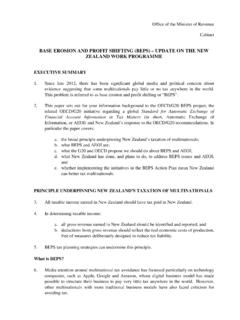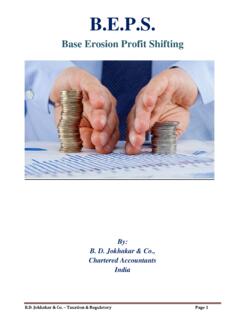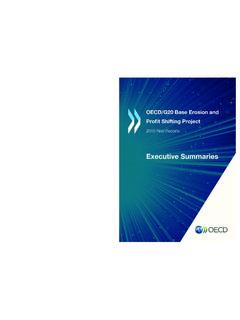Transcription of Base erosion and profit shifting in multinational corporations
1 E base erosion and profit shifting in multinational corporations Vedang Ratan VATSA MBA-Department of IME, IIT Kanpur, India Abstract. The subject of shifting of income by various MNCs or base erosion and profit Sharing (BEPS) motivated by tax reasons has been a matter of attention, globally, in the recent years. In this paper, I provided a literature review of what is known about the issue of BEPS in general and went forward in discussing the empirical approaches that identify shifting of income supported by some data sources and thus summarized the discussion using the same. One of the major observations from this review is that the intensity of BEPS in the recent studies, is smaller than what can be found in the studies done earlier.
2 This manuscript talks about the ways to offer an approach to conceptualize the magnitude of BEPS. It finishes up by featuring the significance of existing economic, financial and legal frictions as limitations on BEPS and by examining the ways by which future research may demonstrate these constraints efficiently. Keywords: BEPS, profit sharing, base erosion in MNCs, taxation, multinational firms. JEL Classification: F01. Theoretical and Applied EconomicsVolume XXV (2018), No. 3(616), Autumn, pp. 179-186180 Vedang Ratan Vatsa I. Introduction The topic of taxation of MNCs or international taxation in general has as of late picked up a high amount of political prominence and attention.
3 G20 leaders after having a meet at the city of Los Cabos, Mexico in the year 2012 furnished the statement We reiterate the need to prevent base erosion and profit shifting and we will follow with attention the ongoing work of the OECD (Organization for Economic Cooperation and Development) in this area ( ). The issues encompassing BEPS were portrayed in one of the major OECD report in February 2013. Eventually, a plan of action on BEPS was created in July 2013, which comprised of 15 particular steps that are expected to encourage collaboration among the government bodies concerning the tax assessment of MNCs. The general point to cover is to better align rights to tax with economic activity.
4 While investigating these propositions, one of the important considerations is the level of BEPS activities by the MNCs. This manuscript gives an overview of the observations of income shifting within MNCs. The study centers around the predominant approach based on the economic aspects of shifting of income, which goes back to Hines and Rice (1994). Different methodologies within the subject of economics are additionally reviewed, including strategies proposed by Dharmapala and Riedel (2013) and Dyreng and Markle (2013). One of the major subjects that comes up is that a move from country level datasets to the firm-level microdata has enormously contributed to the validity of the measures of BEPS.
5 In the recent literatures, the observed amount of BEPS is comparatively lesser that that found in the previous studies. An estimate, in light of the study of a meta regression by Heckemeyer and Overesch (2013), of elasticity of the income reported the rate of tax differential over nations is recorded to be This involves a 10% increment in the difference of the rate of tax involving a subsidiary and its parent (for instance, in light of the fact that the rate of tax in company s nation went down from 35% to 25%) would make the reported income before tax to increase by 8% (for instance, from $1,000,000 to $1,080,000). The manuscript also reviews particular issues identifying with BEPS that have been the subject of various policy debates.
6 Eventually, the manuscript looks to offer a system to investigate the size and estimation of BEPS and the implications involved. Specifically, while the evaluated size of BEPS is lesser than what was found in the earlier studies, it is, however, unclear whether it is to be seen as being 'huge' or 'little' for policy purposes. The findings additionally recommend the significance of present economic constraints as checks on BEPS. base erosion and profit shifting in multinational corporations 181 II. Background The purpose of development of MLI was to quickly implement the measures related to the tax treaty, that were introduced under Actions 2, 6, 7 and 14 (hybrid mismatches, treaty abuse, permanent establishments and mutual agreement procedures respectively) of the BEPS project.
7 In order to maximize the participation, MLI provides with flexibility to judge the parts of MLI to be adopted, rejected or to be modified, to the potential signatories. To be specific, MLI allows the following jurisdictions: Choice the tax treaties that the MLI modifies (CTAs: Covered Tax Agreements). Alternatives to fulfil the minimum standards under the Actions 6 and 14 (treaty abuse and mutual agreement procedures respectively) of the BEPS project. Potential of opting out from certain provisions CTAs whether completely or partially. Ability to exert any optional provisions. With signing of the same, each signatory deposited a record to the OECD that listed their CTAs along with their reservations the provisions of MLI.
8 After the completion of the ratification process (including the modification requests that may be asked), the signatories may decide their positions on MLI. It can be observed that the taxpayers may need to work more closely and lay attention to the options that the countries made under the MLI. They need to calculate and consider the impact of MLI on their operations and thus, work on the policies to address the impact. III. Observations and methodologies: Literature review The study by Hines and Rice (1994) is based on the observation that the income before tax of any company is the total of true and shifted incomes. The shifted income here, may either be positive or negative.
9 True income includes that capital and the labor estimations and it is intended to reflect the overall work efficiency of the company. Shifted income, on the other hand, depends upon the tax structure of the country in which the company is based and can be set as per the value of the company. It is dependent upon the tax incentives of the country and determines the amount to be moved in or out of the company. The approach according to Hines and Rice may be represented as: log i = 0+ 1 i+ 2 logKi+ 3 logLi+ Xi + i. (1) where: i profits earned by the MNC i . The specification is taken to be log-linear in nature.
10 It does not include loss-making companies in the sample. Ki Company i s capital inputs. 182 Vedang Ratan Vatsa Li Company i s labor inputs. 0 Constant. 1 Extent of income shifts by any MNC i . Xi Vector of additional affiliate-level controls. i Tax incentive to shift profits into or out of affiliate i . i Error term. With the use of Panel data (using different observations of the same company over different time values), we may use the previous equation as: log it = 1 it + 2logKit + 3logLit +Xit + i + t + it (2) where: it profits earned by the MNC i in the year t . i Affiliate fixed effect.













